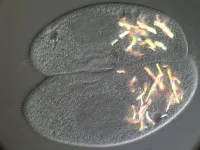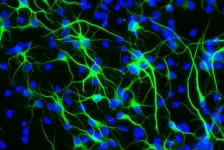(Press-News.org) The mating process is one of the most important mechanisms for maintaining genetic variation in natural populations. The emergence of sexual reproduction turned out to be the most important evolutionary innovation that facilitated the evolution of eukaryotes. Paramecium is a well-known genus of ciliated protists with a complex system of 'sexes', or mating types. Paramecium reproduces asexually, by binary fission, which is not related to the mating process. During conjugation, Paramecium of compatible mating types exchange haploid nuclei, equivalent to gametes. The nuclei of each organism then fuse to form a diploid genome. This genome is stored in germline micronuclei of the exconjugants. It then undergoes large-scale rearrangements in the somatic macronucleus, including the elimination of virtually all non-coding DNA. Thus, there are two Paramecium cells before the formation of a conjugating pair, as well as after conjugation: no offspring are produced. However, by the time the two cells go their separate ways, both of them will have changed. Firstly, now they will have become genetically identical, and, secondly, they will both have acquired a new genetic identity, different from their 'parental' genotype.
'I will draw an analogy with humans, whose sexual activity is not always associated with procreation as well. It is as if after sexual intercourse the two partners became identical twins. Moreover, the transformation is so radical that they change directly into their own offspring, as if being reincarnated in the same body but genetically different,' explains one of the authors of the study, professor in the Department of Microbiology of St Petersburg University, Dr. Alexey Potekhin.
For several years, the scientists have studied mating-type systems in five closely related species of the ciliate Paramecium. They sought to find out how mating-type polymorphism is maintained in organisms that do not exhibit any sexual characteristics. 'Ciliates are unorthodox about sex. For example, different Paramecium species have multiple, as well as binary mating types systems. The multitude of mating types significantly expands the choice of mating partners. Most importantly, mating occurs between cells of different genotypes, i.e. of different mating types. As for the binary systems, they are what we humans call "bisexual". As practice has shown, two sexes are quite enough,' says Alexey Potekhin.
Some species of Paramecium have two mating types, O (Odd) and E (Even), which might be broadly called representatives of different 'sexes', since conjugation occurs only between cells of different mating types. However, the mechanisms of sex, or mating-type, determination remained unknown for a long time. Previous work in Paramecium tetraurelia revealed the key role of the mtA gene. It encodes a transmembrane protein that is specifically expressed in sexually reactive cells of type E. The mtA protein is directly involved in the species-specific recognition of type O reactive cells. For E expression, the mtA protein requires two other proteins, mtB and mtC, which encode factors that are necessary for mtA transcription in E reactive cells. All three proteins are specifically required for type E expression, whereas no gene is specifically required for type O expression.
To reconstitute functional genes in the somatic genome, ciliates rely on the programmed genome rearrangements, which include the excision of the unnecessary elements from coding sequences in the macronucleus. This excision event depends on a special class of small RNAs that scan the parental macronuclear genome to identify missing sequences and correlate it with the new one, which is to be formed after conjugation. Consequently, all DNA sequences that are absent from the parental macronucleus are eliminated. The parental macronucleus is then destroyed, and the new functional macronucleus is formed. 'Meanwhile, the new macronuclear genotypes differ from the parental one, as it is expected to be as a result conjugation,' notes Alexey Potekhin.
The mating type of Paramecium tetraurelia is inherited maternally by programmed genome rearrangements. In other words, each progeny acquires the mating type of its cytoplasmic parent. 'A type O cell has an mtA gene that is inactivated during development, because the DNA segment, containing the mtA promoter (its transcription start site) and elements directly downstream, is reminiscent of transposons. The latter are also known as transposable elements, or jumping genes. They make up a large fraction of the non-coding DNA and can be eliminated from the macronuclear genome as unnecessary. In such case, this fragment will always be deleted in the next generations during macronuclear development. After all, it has already been lost from the "template". Thus, the mtA gene is inactivated, and the progeny inherits the mating type O,' explains Alexey Potekhin.
Among species with cytoplasmic inheritance of mating types, there are several species of the Paramecium aurelia complex: P. biaurelia, P. sexaurelia, P. septaurelia, P. octaurelia, P. decaurelia, and P. dodecaurelia. In the new study, the scientists have shown that these sibling species use the same mechanism, but different modes of mating-type determination. Several species use the same regulation mechanism as P. tetraurelia - an epigenetically inherited deletion of the fragment containing the mtA promoter and the elements directly downstream from the start site. Conversely, in P. sexaurelia, it is the last of the base pairs of the coding sequence of the mtA gene that undergo correction during genome rearrangements. In two other Paramecium species, P. biaurelia and P. septaurelia, the mtB gene was found to be rearranged differently - some fragments of the mtB gene may get deleted leading to the mtB deficiency. Due to the absence of functional mtB, the mtA gene cannot function properly. Thus the absence of functional mtB is what determines mating type O in these species.
'When I was a student 25 years ago, I was amazed that within a small group of ciliates there are three different modes of mating-type determination and inheritance. Such evolutionary plasticity of mating-type systems is unique and cannot be found in multicellular organisms. At the time, it was an absolute mystery, because then no one had an idea of genome scanning, nor of mating-type genes. Our research team has been able to make a great contribution to the study of this phenomenon, and I am pleased with the scientific results we have achieved. It has been a real scientific quest,' stresses Alexey Potekhin.
In Paramecium tredecaurelia, mating types are not inherited cytoplasmically, but follow a classical pattern of Mendelian inheritance. It has been shown that in that species, O and E mating types are genetically determined by the loss of a single nucleotide in the mtA promoter in type E clones. The genome of P. tredecaurelia contains no functional mtB gene; therefore, another transcription factor plays its role. The conducted experiments enabled the scientists to establish that the transcription factor binding site is located in the promoter region with a discovered one nucleotide deletion, while the mtA gene is activated by such a promoter. If there is no deletion, then the site is not recognised and the mtA gene is not expressed during sexual reactivity. The same binding site in the mtA promoter is also observed in three more species of the Paramecium aurelia complex, with all of them lacking the mtB gene.
'This implies that in the evolution of these sibling species, there occurred several evolutionary transitions between mating-type determination systems. Despite different molecular solutions, the result was always the same: in a natural population, there will be cells of both mating types. The evolutionary history of the Paramecium aurelia illustrates that any regulation mechanism for maintaining mating-type polymorphism in cell populations can take hold, involving mating-type biased gene expression and programmed genome rearrangements. This shows how important the mating process is even for unicellular organisms,' notes Alexey Potekhin.
INFORMATION:
LOUISVILLE, Ky. - The SARS-CoV-2 pandemic has caused tremendous upheaval, leading to more than 2.3 million deaths worldwide and 465,000 in the United States. Understanding the impact of seasonal temperature changes on transmission of the virus is an important factor in reducing the virus's spread in the years to come.
SARS-CoV-2 belongs to a large family of human coronaviruses, most of which are characterized by increased transmission in cooler, less humid months and decreased transmission in warmer, more humid months. With this understanding, researchers at the University of Louisville's Christina ...
HSE University researchers Yuri Markov and Natalia Tyurina discovered that when people visually estimate the size of objects, they are also able to consider their distance from the observer, even if there are many such objects. The observers rely not only on the objects' retinal representation, but also on the surrounding context. The paper was published in the journal Acta Psychologica.
Multiple studies in visual 'ensemble statistics' have proven that humans are able to visually estimate the statistical characteristics of multiple objects in a fast and rather ...
ROCHESTER, Minn. ? Researchers at Mayo Clinic have combined results from a functional test measuring the effect of inherited variants in the BRCA2 breast and ovarian cancer gene with clinical information from women who received genetic testing to determine the clinical importance of many BRCA2 variants of uncertain significance (VUS). The findings were published today in a study in the American Journal of Human Genetics.
"There are 4,565 different VUS in the BRCA2 gene listed in the National Institutes for Health (NIH) Clinical Variant Database," says Fergus Couch, Ph.D., a breast cancer researcher at ...
A gene linked to unusually long lifespans in humans protects brain stem cells from the harmful effects of stress, according to a new study by Weill Cornell Medicine investigators.
Studies of humans who live longer than 100 years have shown that many share an unusual version of a gene called Forkhead box protein O3 (FOXO3). That discovery led Dr. Jihye Paik, associate professor of pathology and laboratory medicine at Weill Cornell Medicine, and her colleagues to investigate how this gene contributes to brain health during aging.
In 2018, Dr. Paik and her team showed that mice who lack the FOXO3 gene ...
How much personal information can our phone apps gather through location tracking? To answer this question, two researchers - Mirco Musolesi (University of Bologna, Italy) and Benjamin Baron (University College London, UK) - carried out a field study using an app specifically developed for this research. Through the app employed in the study - published in Proceedings of the ACM on Interactive, Mobile, Wearable and Ubiquitous Technologies - researchers were able to identify which kind of personal information the app extracted and its privacy sensitivity according to users.
"Users are largely unaware of the privacy implications ...
The University of Leeds has coordinated a study with 170 experts from 35 countries, including E.T.S. Agronomic Engineering lecturer Luis Perez Urrestarazu. The study conclusions have just been published in the journal Nature Ecology & Evolution.
The researchers highlighted opportunities to improve the way green spaces are monitored and maintained and helping people to interact with and appreciate the natural world around them. Similarly, as autonomous vehicles become more widely used in cities, pollution and traffic congestion are set to fall.
But they also warn that advances in robotics and automation could be harmful to the environment. They may, for example generate new sources of waste and pollution, with potentially substantial negative implications for urban nature. Cities may ...
Social identity is a factor linked to wellbeing and community participation. Various studies have demonstrated the link existing between ethnic identity and empowerment and that the interaction between both of them leads to a rise in the indices of wellbeing and community participation. However, the nature of these relationships may be determined by the fact that the individual perceives his or her own group as a minority one and/or one that is subject to discrimination. In fact, these relations emerge mostly in groups that find themselves in a minority situation and/or one of discrimination, but not in groups that are more hegemonic or in the majority.
To further ...
Parent education programs and interventions that begin shortly after the birth of a child have shown to significantly impact parenting behaviors that support social and academic engagement for children growing up in poverty, according to a study led by pediatricians and psychologists across the country, including NYU Grossman School of Medicine, NYU Steinhardt, and the University of Pittsburgh.
The study, published today in the journal Pediatrics, examines the Smart Beginnings Project, a first-of-its-kind comprehensive approach to the promotion of school readiness in low-income families. This model addresses one of the most important causes of inequity - that many children from ...
Researchers at the Institut de Neurociències of the Universitat Autònoma de Barcelona (INc-UAB) obtained a highly accurate recreation of human glioblastoma's features using a novel 3D microscopy analysis. The study, published in the journal Acta Neuropathologica Communications, provides new information to help with the diagnose, by finding therapeutical targets and designing immunotherapeutical strategies.
This new analysis of 3D images and quantitative data "will help to appreciate from within how the tumor is built in its full dimensionality, and to identify where different cell types are located", explains George Paul Cribaro, first author of the study. "It provides more complete information than the usual 2D analyses performed for ...
Prion diseases are a group of rapidly progressive, fatal and infectious neurodegenerative disorders affecting both humans and animals: Bovine Spongiform Encephalopathy (BSE) or 'mad cow' disease is one of the most famous since in 1996 scientists found that the agent responsible for the disease in cows, is the same agent responsible for the so-called variant Creutzfeldt-Jakob Disease (vCJD), a disease affecting humans.
A new study carried out by SISSA - Scuola Internazionale Superiore di Studi Avanzati in collaboration with other institutions including Genos Glycoscience ...




